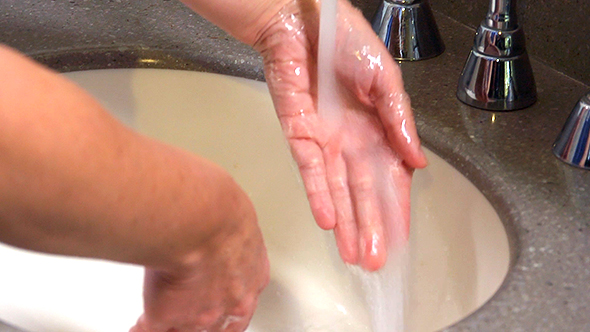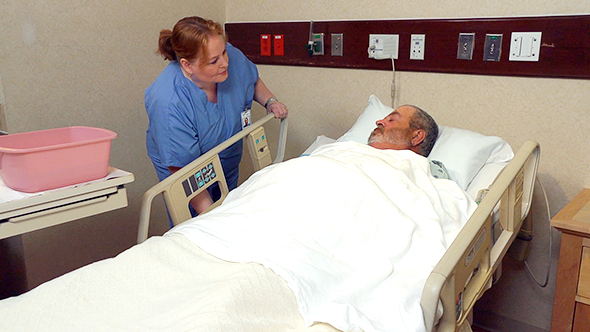Heat and Cold Applications
Select a Skill:
- » Performing a Hot or Cold Soak
- » Performing a Sitz Bath
- » Applying a Hot or Cold Compress
- » Applying a Hot or Cold Pack or an Ice Bag, Collar, or Glove
- » Using an Aquamatic or Aquathermia Pad
Take the Review Test:

Purpose

- Heat applications can be applied to almost any body part. They are often used for musculoskeletal injuries or problems (sprains, arthritis). They cause blood vessels to dilate (expand or open wider). Heat relieves pain, relaxes muscles, promotes healing, reduces tissue swelling, and decreases joint stiffness.
- Heat applications may be moist (water is in contact with the skin) or dry (water is not in contact with the skin). A hot compress is a moist heat application. It is a soft pad (usually made of cloth) that is applied over a body area.
- Water conducts heat. Moist heat has greater and faster effects than dry heat. Heat penetrates deeper with a moist application. To prevent injury, moist heat applications have lower temperatures than dry heat applications.
- Cold applications are often used to treat sprains and fractures. They reduce pain, prevent swelling, and decrease circulation and bleeding. Cold applications cause blood vessels to constrict. They are useful right after an injury.
- Cold applications may be moist or dry. Moist cold applications penetrate deeper—and are colder—than dry ones. A cold compress is a moist cold application.
- Follow the rules for applying heat and cold:
- Know how to use the equipment. Follow the manufacturer’s instructions.
- Measure the temperature of moist applications. Follow agency policies for safe temperature ranges.
- Do not apply very hot (above 106˚F [41.1˚C]) applications.
- Ask the nurse what the temperature should be.
- Know the exact site of the application. Have the nurse show you the site.
- Provide for privacy. Expose only the body part involved.
- Maintain comfort and body alignment during the procedure.
- Observe the skin every 5 minutes for signs of complications.
- Do not let the person change the temperature of the application.
- Know how long to leave the application in place—up to 15 to 20 minutes.
- Place the call light within the person’s reach.
- Complete a safety check before leaving the room.
Equipment
Roll cursor over items to see labels. For the purposes of clearly depicting the equipment, a barrier is not shown in this photo. When providing care, a barrier should always be placed on the surface before placing the equipment.

Basin
Bath thermometer
Bath blanket
Plastic wrap
Hand Towel
Washcloth
Rolled gauze
Waterproof pad
Kidney basin
Gauze sponges
Delegation
- Follow delegation guidelines. Before applying a hot or cold compress, obtain this information from the nurse and care plan:
- The type of application—hot or cold compress
- How to cover the application
- What temperature to use
- The application site
- How long to leave the application in place
- What observations to report and record
- When to report observations
- What patient or resident concerns to report at once
Preparation

- Observe quality-of-life measures.
- Review the information under Delegation and Safety and Comfort.
- Practice hand hygiene.
- Collect equipment.
- Identify the person. Check the ID bracelet against the assignment sheet. Also call the person by name.
Safety

- Check the person every 5 minutes during hot or cold compress application.
- Some persons have medicated patches or ointments applied to the skin. Do not apply heat over such areas.
Comfort
- Cold applications can cause chills and shivering. Provide for warmth. Use bath blankets or other blankets as needed.
Procedure Video
Audio Description: OFFFollow-up Care

- Provide for comfort.
- Place the call light within reach.
- Raise or lower bed rails. Follow the care plan.
- Unscreen the person.
- Clean, rinse, dry, and return re-usable items to their proper places. Follow agency policy for soiled linen. Wear gloves for this step.
- Complete a safety check of the room.
- Remove and discard the gloves. Practice hand hygiene.
Reporting/Recording
- Report and record your observations, including:
- Complaints of pain, discomfort, numbness, or burning
- Excessive redness
- Blisters
- Pale, white, or gray skin
- Cyanosis (bluish color)
- Shivering
- Time, site, and length of application
Review Questions
Select the best answer.
1. What type of heat and cold do compresses supply?
Select the best answer.
2. What is a purpose of a cold compress?
Select the best answer.
3. When applying a hot compress, which action is appropriate?
 Leave the compress in place until it is cool to the touch.
Leave the compress in place until it is cool to the touch. Observe the person’s skin for goosebumps (piloerection).
Observe the person’s skin for goosebumps (piloerection). Check the skin every 15 minutes until the treatment is complete.
Check the skin every 15 minutes until the treatment is complete. Use hot water—98˚F to 106˚F (36.6˚C to 41.1˚C)—to wet the compress.
Use hot water—98˚F to 106˚F (36.6˚C to 41.1˚C)—to wet the compress.
Select the best answer.
4. How often should you check a hot or cold compress and the skin under it?
Select the best answer.
5. How should you cover a hot compress?
 Wrap a waterproof pad around the hot compress.
Wrap a waterproof pad around the hot compress. Apply an aquamatic pad tightly around the compress.
Apply an aquamatic pad tightly around the compress. Apply plastic wrap and a bath towel over the compress.
Apply plastic wrap and a bath towel over the compress. Drape a towel or bath blanket over the area with the compress.
Drape a towel or bath blanket over the area with the compress.
You have completed the Review Questions for this skill. To take the Review again select the Start Over button. To proceed to another skill select from the dropdown menu. Select the Home or Back button to proceed to the next section.

